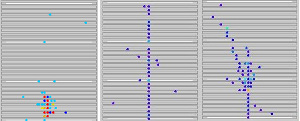 |
 |
|||||||||||||
|
|||||||||||||
|
|||||||||||||
|
Even though last week's "What is it?" does show recent test results it is not an image of temperature mapping of a cavity, sorry. Guest author and calorimeter expert Frank Simon explains what we really see: The "What is it?" image of last week’s ILC NewsLine is a picture-perfect example of why we now often call the calorimeter prototypes for the ILC "imaging calorimeters". To start with the solution, if you quickly want to know if you got it right: The picture shows three different types of particles in the CALICE tungsten hadron calorimeter prototype. From left to right, they are an electron, a muon and a pion. The images come from the recent test beam at CERN. But now, from the beginning: The CALICE (Calorimeter for Linear Collider Experiment) collaboration develops and studies highly granular calorimeters optimised for particle flow, a sophisticated event reconstruction technique for future linear colliders. The newest addition to the detectors that were tested by CALICE is a hadron calorimeter with tungsten absorber plates. at the Compact Linear Collider (CLIC) Study, where the collision energy of 3 TeV leads to very high-energetic jets. To contain such jets in the calorimeters to measure their energy accurately, more material than in the case of ILC detectors is required. The way to achieve this without increasing the size of the large experimental magnet, which would be very expensive and technologically challenging, is to use denser absorbers in the calorimeters. This allows us to fit more material for the particles to interact in into the same volume. And tungsten is as dense as things get, making it a natural choice for such a detector. To study how such a detector performs, the CERN Linear Collider Detectors group and CALICE have constructed a prototype, which uses one-centimetre-thick tungsten plates (actually a tungsten alloy with a density of close to 18 g/cm3) and the active layers of the CALICE analogue hadron calorimeter. In November, this prototype was tested at the CERN Proton Synchrotron with a variety of different particles at energies from 1 to 10 GeV. The image of the week shows an electron, a muon and a pion at 8 GeV. It reveals the different behaviour of these particles in matter, and some of the features of a tungsten calorimeter: Muons lose energy primarily by ionisation, and penetrate matter easily, as can be seen in the event display. Electrons create electromagnetic showers in the absorber material. The evolution is governed by the radiation length, about three millimetres in tungsten. That leads to very compact electromagnetic showers, as the picture shows. The characteristic size of hadronic showers, on the other hand, is given by the nuclear interaction length, which is a factor of 30 larger than the radiation length in tungsten. That is why the pion shower is much more extended, with secondary particles produced in the reactions in the absorbers clearly visible in the calorimeter. On top of that, hadronic showers also contain electromagnetic subshowers. Those come about when neutral pions are created as secondary particles in the interactions with material. Those neutral pions immediately decay into two photons, giving rise to electromagnetic showers. Those electromagnetic components again exhibit the compact structure that characterises the interaction of electrons in the calorimeter, as is clearly visible in the central dense part of the pion event. In a tungsten calorimeter, the difference between electromagnetic and hadronic shower components are more pronounced than in the steel calorimeter studied previously, opening new paths to the study of hadronic interactions in matter. -- Frank Simon
To learn more about hadron calorimeters and the work of the CALICE collaboration, visit these previous ILC NewsLine features:
- Ten thousand eyes on new physics - Key evaluations underway for particle flow calorimetry - Textbook tests with tungsten |
|||||||||||||
| © International Linear Collider |
